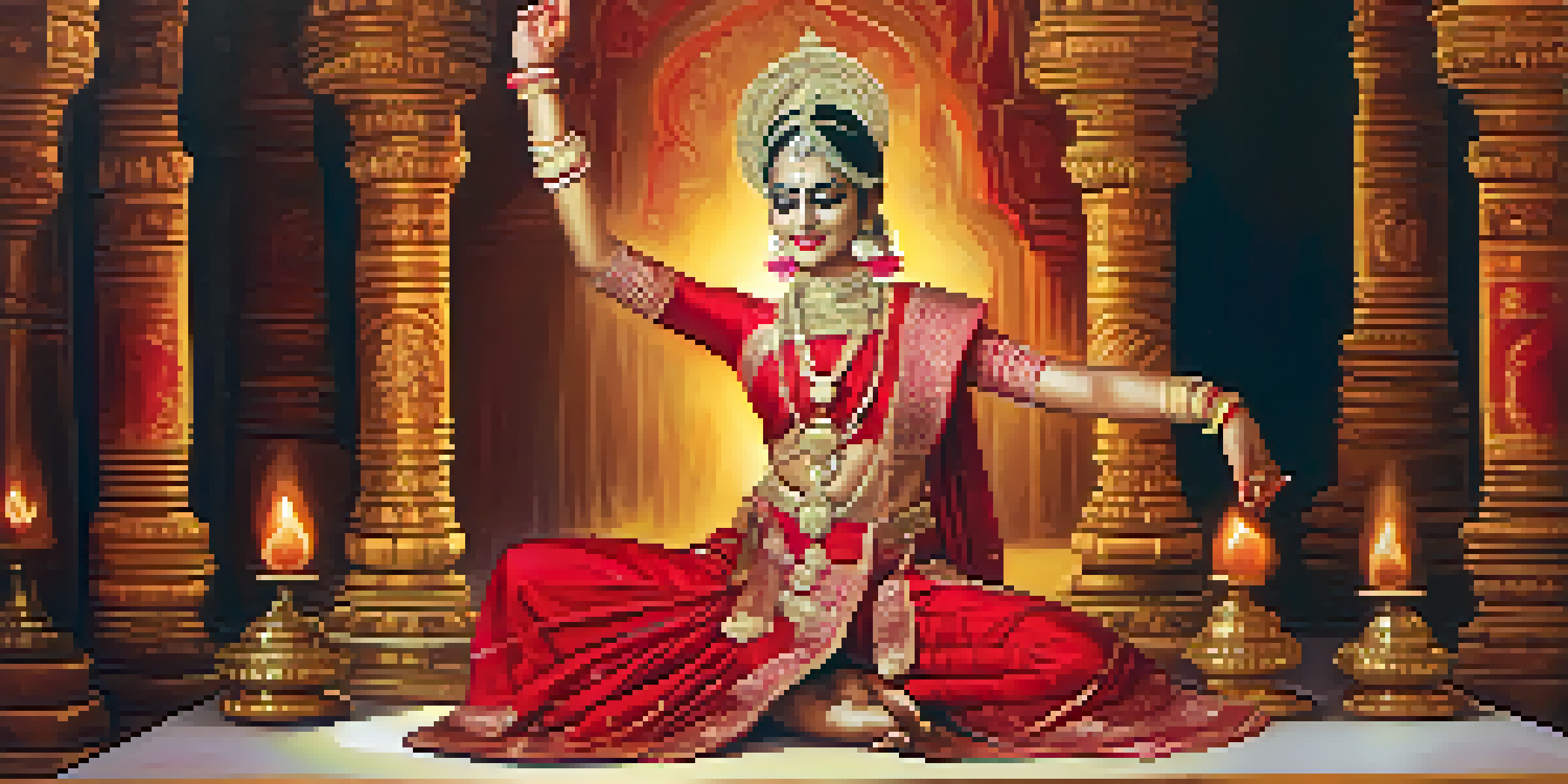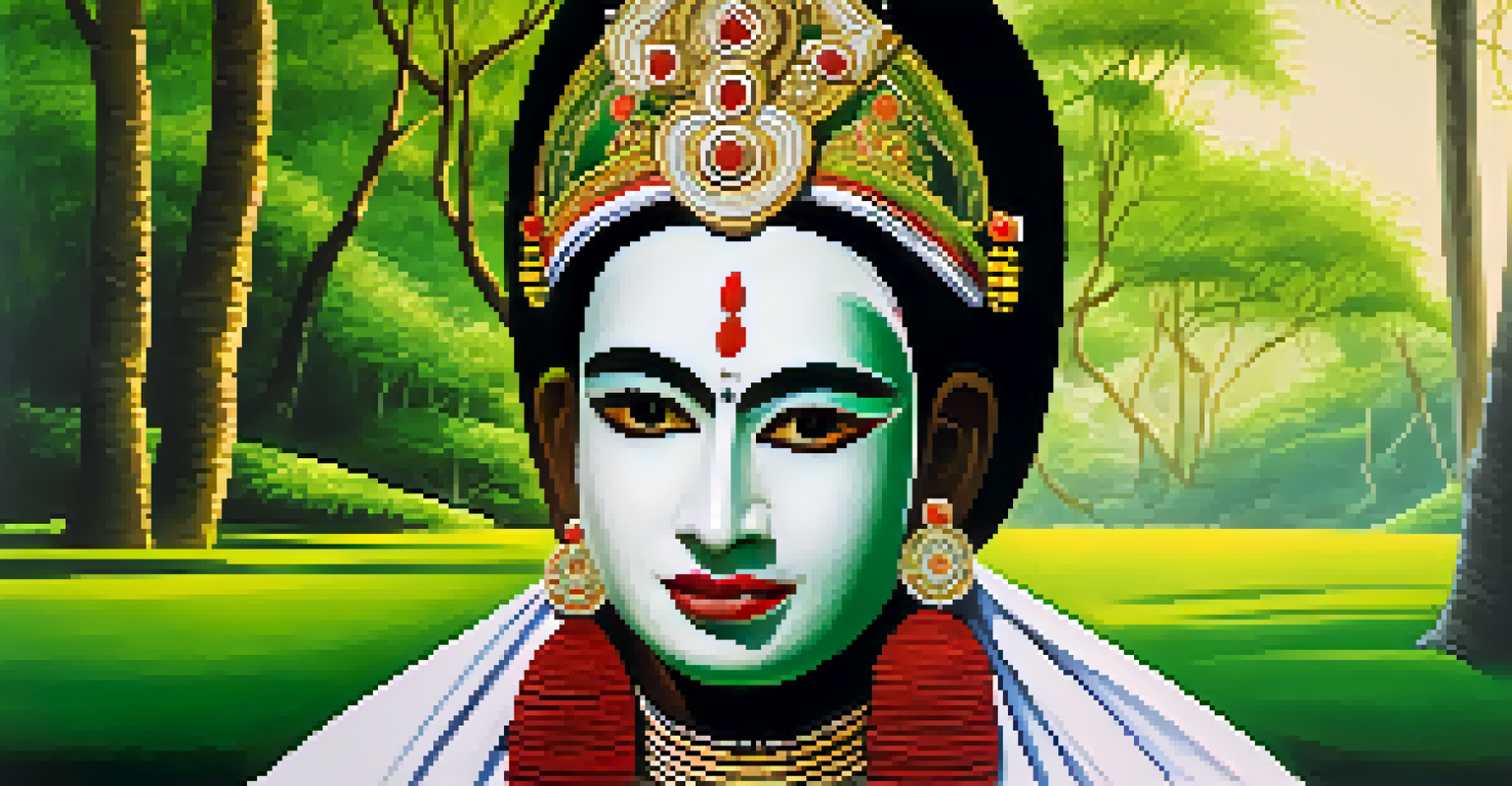Cultural Significance of Traditional Indian Dance Forms

The Roots of Traditional Indian Dance Forms
Traditional Indian dance forms are deeply rooted in the country’s history, tracing back thousands of years. These dances were often linked to religious rituals and storytelling, serving as a medium to convey spiritual and moral lessons. For example, Bharatanatyam, one of the oldest dance forms, originated in the temples of Tamil Nadu, where dancers performed to honor the deities.
Dance is the hidden language of the soul.
Over time, these art forms evolved, influenced by various cultural exchanges and regional styles across India. Each dance form carries its own unique narrative, reflecting the traditions and values of the community it hails from. This rich tapestry of history demonstrates how dance has always been a vital part of Indian culture.
Today, these dance forms not only preserve ancient traditions but also adapt to contemporary influences, ensuring their relevance for future generations. As we explore these traditional dances, we recognize how they serve as a bridge connecting the past with the present.
Symbolism in Indian Dance Movements
Every gesture and movement in traditional Indian dance is laden with symbolism, often representing various emotions and stories. For instance, the mudras, or hand gestures, in Kathakali can convey different characters and emotions, allowing dancers to narrate intricate tales without spoken words. This expressive vocabulary of movement allows for a rich storytelling experience.

Moreover, the facial expressions, known as 'abhinaya', play a crucial role in conveying the emotional depth of the performance. Dancers undergo rigorous training to master these expressions, making them integral to the storytelling process. This blend of movement and expression creates a language that transcends words, connecting audiences to the narrative on a deeper level.
Dance as Cultural Heritage
Traditional Indian dance forms preserve cultural identity and heritage, serving as a vital connection to the past in a rapidly globalizing world.
Such symbolic representations are not just artistic; they also reflect societal values and philosophies. Through these performances, audiences gain insights into the cultural fabric of India, fostering a greater appreciation for its diverse traditions.
Role of Traditional Dance in Religious Practices
Traditional Indian dance forms are often intertwined with religious practices and celebrations. Many dance styles, such as Odissi and Kathak, have their origins in temple rituals, where they were performed as offerings to deities. This sacred aspect of dance elevates it beyond mere performance, turning it into a spiritual practice.
Through dance, we can express our deepest emotions, tell stories, and celebrate our cultural heritage.
During festivals and religious ceremonies, these dances serve as a medium to express devotion and reverence. For example, the dance-dramas of Ramayana and Mahabharata are performed to recount divine stories, allowing participants and spectators alike to connect with their faith. The immersive experience of watching or performing these dances fosters a sense of community and shared spirituality.
Furthermore, the revival of these dance forms in contemporary religious practices highlights their enduring significance. They continue to inspire new generations, ensuring that the essence of these spiritual traditions remains alive.
Cultural Identity and Heritage Preservation
Traditional Indian dance forms play a pivotal role in preserving cultural identity amid globalization. In a rapidly changing world, these art forms serve as a reminder of India’s rich heritage, helping communities maintain a connection to their roots. Dancers and choreographers often draw on traditional techniques while infusing modern elements, creating a bridge between past and present.
Cultural festivals and competitions celebrate these dance forms, promoting awareness and appreciation within the community. Schools and institutions dedicated to Indian classical dance are vital in training young dancers, ensuring that these traditions are passed down through generations. This educational aspect plays a significant role in sustaining cultural identity.
Symbolism and Storytelling
Every gesture and movement in Indian dance is rich with symbolism, allowing dancers to convey deep emotions and narratives without words.
The international recognition of Indian dance further enhances its cultural significance. By showcasing these art forms on global platforms, they not only represent India but also enrich the global artistic landscape, fostering cross-cultural dialogue and understanding.
Education and Training in Traditional Dance
Education in traditional Indian dance is rigorous and multifaceted, often beginning at a young age. Aspiring dancers typically train under the guidance of a guru, learning both technical skills and the cultural context of their chosen dance form. This mentorship is crucial, as it fosters a deep understanding of the art and its significance.
Dance schools and institutions across India offer structured programs that encompass various dance styles, ensuring a comprehensive education. Workshops and masterclasses conducted by renowned dancers provide students with unique insights and exposure. This blend of formal training and hands-on experience helps cultivate talent and preserve traditional techniques.
Moreover, the importance of performance opportunities cannot be overstated. Recitals and competitions allow students to showcase their skills while receiving feedback from experienced practitioners. This practical aspect of learning reinforces their connection to the dance form and inspires confidence in their artistic journey.
Influence of Indian Dance on Contemporary Art
The influence of traditional Indian dance on contemporary art forms is profound and far-reaching. Many modern choreographers draw inspiration from classical techniques, incorporating them into contemporary dance performances. This fusion not only revitalizes traditional forms but also makes them accessible to a broader audience.
Collaborations between traditional dancers and contemporary artists often result in innovative performances that challenge conventional boundaries. By blending elements from various dance styles, these artists create a unique dialogue that resonates with diverse audiences. This synthesis fosters a greater appreciation for both traditional and contemporary art forms.
Global Impact of Indian Dance
Indian dance has gained international recognition, fostering cross-cultural dialogue and inspiring artists around the world to explore its rich traditions.
Additionally, the incorporation of technology in performances has opened new avenues for expression. Visual effects, lighting, and multimedia elements enhance the storytelling aspect of traditional dances, making them more engaging for modern viewers. This evolution ensures that Indian dance continues to thrive in a dynamic artistic landscape.
Global Recognition and Influence of Indian Dance
In recent years, traditional Indian dance has gained significant global recognition, thanks to the efforts of dedicated artists and cultural ambassadors. International festivals and workshops showcase these dance forms, inviting audiences from around the world to experience their beauty and intricacy. This exposure has sparked a growing interest in Indian culture and arts globally.
Indian dance companies and troupes frequently tour internationally, sharing their heritage with diverse audiences. As they perform on foreign stages, they not only entertain but also educate, fostering a deeper understanding of Indian traditions and values. This cultural exchange enriches both the performers and the spectators.

Moreover, the global appeal of Indian dance has inspired many non-Indian artists to explore and incorporate traditional elements into their work. This cross-cultural dialogue highlights the universal themes expressed through dance, emphasizing the power of art to transcend geographical and cultural boundaries.